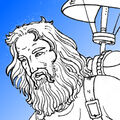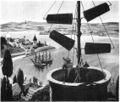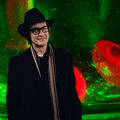Template:Selected anniversaries/March 2: Difference between revisions
No edit summary |
No edit summary |
||
| Line 1: | Line 1: | ||
<gallery> | <gallery> | ||
|| *** DONE: Pics *** | |||
File:Title page of the Astrolabium of Johannes Engel, printed by Johann Emerich, Venice 1494.jpg|link=Johannes Engel (nonfiction)|1453: Doctor, astronomer, and astrologer [[Johannes Engel (nonfiction)|Johannes Engel]] born. He will publish numerous almanacs, planetary tables, and calendars. | File:Title page of the Astrolabium of Johannes Engel, printed by Johann Emerich, Venice 1494.jpg|link=Johannes Engel (nonfiction)|1453: Doctor, astronomer, and astrologer [[Johannes Engel (nonfiction)|Johannes Engel]] born. He will publish numerous almanacs, planetary tables, and calendars. | ||
| Line 12: | Line 14: | ||
||1825: Roberto Cofresí, one of the last successful Caribbean pirates, is defeated in combat and captured by authorities. Pic (statue). | ||1825: Roberto Cofresí, one of the last successful Caribbean pirates, is defeated in combat and captured by authorities. Pic (statue). | ||
||1829: Karl Gottfried Hagen dies ... chemist. | ||1829: Karl Gottfried Hagen dies ... chemist. Pic. | ||
||1830: Samuel Thomas von Sömmerring dies ... physician, anatomist, and anthropologist. Pic. | ||1830: Samuel Thomas von Sömmerring dies ... physician, anatomist, and anthropologist. Pic. | ||
| Line 20: | Line 22: | ||
||1838: Jean Alexander Heinrich Clapier de Colongue born ... marine engineer and founder of a theory of magnetic deviation for magnetic compasses, living and working in Imperial Russia. Pic. | ||1838: Jean Alexander Heinrich Clapier de Colongue born ... marine engineer and founder of a theory of magnetic deviation for magnetic compasses, living and working in Imperial Russia. Pic. | ||
||1838: Viktor von Lang born ... chemist. He is counted among the pioneers and founders of crystal physics. | ||1838: Viktor von Lang born ... chemist. He is counted among the pioneers and founders of crystal physics. Pic. | ||
||1840: Heinrich Wilhelm Matthias Olbers dies ... physician and astronomer. | ||1840: Heinrich Wilhelm Matthias Olbers dies ... physician and astronomer. Pic. | ||
||1866: George Chandler Whipple born ... civil engineer and an expert in the field of sanitary microbiology. His career extended from 1889 to 1924 and he is best known as a co-founder of the Harvard School of Public Health. Whipple published some of the most important books in the early history of public health and applied microbiology. Pic. | ||1866: George Chandler Whipple born ... civil engineer and an expert in the field of sanitary microbiology. His career extended from 1889 to 1924 and he is best known as a co-founder of the Harvard School of Public Health. Whipple published some of the most important books in the early history of public health and applied microbiology. Pic. | ||
| Line 28: | Line 30: | ||
||1878: Wander Johannes de Haas (2 March 1878 – 26 April 1960) was a Dutch physicist and mathematician. He is best known for the Shubnikov–de Haas effect, the de Haas–van Alphen effect and the Einstein–de Haas effect. Pic: https://ro.wikipedia.org/wiki/Wander_Johannes_de_Haas | ||1878: Wander Johannes de Haas (2 March 1878 – 26 April 1960) was a Dutch physicist and mathematician. He is best known for the Shubnikov–de Haas effect, the de Haas–van Alphen effect and the Einstein–de Haas effect. Pic: https://ro.wikipedia.org/wiki/Wander_Johannes_de_Haas | ||
||1880: John Benjamin Macneill dies ... engineer. | ||1880: John Benjamin Macneill dies ... engineer ... railway works in Ireland. No DOB. Pic. | ||
||1880: Alfred James Lotka born ... mathematician, physical chemist, and statistician, famous for his work in population dynamics and energetics. An American biophysicist, Lotka is best known for his proposal of the predator–prey model, developed simultaneously but independently of Vito Volterra. The Lotka–Volterra model is still the basis of many models used in the analysis of population dynamics in ecology. Pic. | ||1880: Alfred James Lotka born ... mathematician, physical chemist, and statistician, famous for his work in population dynamics and energetics. An American biophysicist, Lotka is best known for his proposal of the predator–prey model, developed simultaneously but independently of Vito Volterra. The Lotka–Volterra model is still the basis of many models used in the analysis of population dynamics in ecology. Pic. | ||
| Line 42: | Line 44: | ||
||1901: Grete Hermann born ... mathematician and philosopher. Pic. | ||1901: Grete Hermann born ... mathematician and philosopher. Pic. | ||
||1902: Edward Condon born ... physicist and academic. | ||1902: Edward Condon born ... physicist and academic ... nuclear physicist, a pioneer in quantum mechanics, and a participant in the development of radar and nuclear weapons during World War II as part of the Manhattan Project.[3] The Franck–Condon principle and the Slater–Condon rules are co-named after him. Pic. | ||
||1910: Charles Pisot born ... mathematician. He is chiefly recognized as one of the primary investigators of the numerical set associated with his name, the Pisot–Vijayaraghavan numbers. Pic: http://www-history.mcs.st-andrews.ac.uk/PictDisplay/Pisot.html | ||1910: Charles Pisot born ... mathematician. He is chiefly recognized as one of the primary investigators of the numerical set associated with his name, the Pisot–Vijayaraghavan numbers. Pic: http://www-history.mcs.st-andrews.ac.uk/PictDisplay/Pisot.html | ||
| Line 48: | Line 50: | ||
File:Arthur Stanley Eddington.jpg|link=Arthur Eddington (nonfiction)|1911: Astronomer, physicist, and mathematician [[Arthur Eddington (nonfiction)|Arthur Eddington]] builds new type of [[scrying engine]] which detects and prevents [[crimes against mathematical constants]]. | File:Arthur Stanley Eddington.jpg|link=Arthur Eddington (nonfiction)|1911: Astronomer, physicist, and mathematician [[Arthur Eddington (nonfiction)|Arthur Eddington]] builds new type of [[scrying engine]] which detects and prevents [[crimes against mathematical constants]]. | ||
||1921: Vitold Belevitch born ... mathematician and electrical engineer of Russian origin who produced some important work in the field of electrical network theory. | ||1921: Vitold Belevitch born ... mathematician and electrical engineer of Russian origin who produced some important work in the field of electrical network theory. Pic. | ||
||1922: Frances Spence born ... one of the original programmers for the ENIAC. Pic. | ||1922: Frances Spence born ... one of the original programmers for the ENIAC. Pic. | ||
||1913: Georgy | ||1913: Georgy Flyorov born ... physicist who is known for his discovery of the spontaneous fission and his contribution towards the physics of thermal reactions. Pic (stamp). | ||
||1924: David Sayre born ... physicist and mathematician ... pioneered the development of direct methods for protein crystallography and of diffraction microscopy (also called coherent diffraction imaging), later suggesting the use of electron beam lithography for the fabrication of X-ray Fresnel zone plates. Sayre also helped develop the FORTRAN programming language. Pic search good: https://www.google.com/search?q=david+sayre | ||1924: David Sayre born ... physicist and mathematician ... pioneered the development of direct methods for protein crystallography and of diffraction microscopy (also called coherent diffraction imaging), later suggesting the use of electron beam lithography for the fabrication of X-ray Fresnel zone plates. Sayre also helped develop the FORTRAN programming language. Pic search good: https://www.google.com/search?q=david+sayre | ||
| Line 58: | Line 60: | ||
||1927: Kurt Leichtweiss born ... mathematician specializing in convex and differential geometry. Pic. | ||1927: Kurt Leichtweiss born ... mathematician specializing in convex and differential geometry. Pic. | ||
||1949: Captain James Gallagher lands his B-50 Superfortress Lucky Lady II in Fort Worth, Texas after completing the first non-stop around-the-world airplane flight in 94 hours and one minute. | ||1949: "Lucky Lady II": Captain James Gallagher lands his B-50 Superfortress Lucky Lady II in Fort Worth, Texas after completing the first non-stop around-the-world airplane flight in 94 hours and one minute. https://en.wikipedia.org/wiki/Lucky_Lady_II Pic airplaine. | ||
||1962: Charles Jean de la Vallée-Poussin dies ... mathematician and academic. | ||1962: Charles Jean de la Vallée-Poussin dies ... mathematician and academic. Pic. | ||
||Henrietta Bolt | ||Henrietta Bolt | ||
| Line 68: | Line 70: | ||
||1985: Carlos Marcello dies ... gangster. Pic. | ||1985: Carlos Marcello dies ... gangster. Pic. | ||
||1995: Researchers at Fermilab announce the discovery of the top quark. | ||1995: Researchers at Fermilab announce the discovery of the top quark. Pic (diagram). | ||
File:Jordan Carson Mark.gif|link=J. Carson Mark (nonfiction)|1997: Mathematician [[J. Carson Mark (nonfiction)|Jordan Carson Mark]] dies. He oversaw the development of nuclear weapons for the US military, including the hydrogen bomb in the 1950s. | File:Jordan Carson Mark.gif|link=J. Carson Mark (nonfiction)|1997: Mathematician [[J. Carson Mark (nonfiction)|Jordan Carson Mark]] dies. He oversaw the development of nuclear weapons for the US military, including the hydrogen bomb in the 1950s. | ||
||1998: Data sent from the Galileo spacecraft indicates that Jupiter's moon Europa has a liquid ocean under a thick crust of ice. | ||1998: Data sent from the Galileo spacecraft indicates that Jupiter's moon Europa has a liquid ocean under a thick crust of ice. Pic. | ||
File:Niles Cartouchian interrogates Fugitive Rubies.jpg|link=Niles Cartouchian|2017: Famed gem detective [[Niles Cartouchian]] captures supervillain [[Fugitive Rubies]]. | File:Niles Cartouchian interrogates Fugitive Rubies.jpg|link=Niles Cartouchian|2017: Famed gem detective [[Niles Cartouchian]] captures supervillain [[Fugitive Rubies]]. | ||
||2017: The elements Moscovium, Tennessine, and Oganesson were officially added to the periodic table at a conference in Moscow, Russia | ||2017: The elements Moscovium, Tennessine, and Oganesson were officially added to the periodic table at a conference in Moscow, Russia. Pic (periodic table diagram). | ||
</gallery> | </gallery> | ||
Revision as of 07:53, 2 March 2019
1453: Doctor, astronomer, and astrologer Johannes Engel born. He will publish numerous almanacs, planetary tables, and calendars.
1478: Artist, inventor, and crime-fighter Leonardo da Vinci writes a letter to Johannes Engel, suggesting the need for an almanac of crimes against astronomical constants.
1791: Long-distance communication speeds up with the unveiling of a semaphore telegraph machine in Paris.
1911: Astronomer, physicist, and mathematician Arthur Eddington builds new type of scrying engine which detects and prevents crimes against mathematical constants.
1972: The Pioneer 10 space probe is launched from Cape Canaveral, Florida with a mission to explore the outer planets.
1997: Mathematician Jordan Carson Mark dies. He oversaw the development of nuclear weapons for the US military, including the hydrogen bomb in the 1950s.
2017: Famed gem detective Niles Cartouchian captures supervillain Fugitive Rubies.






